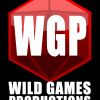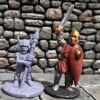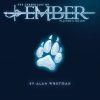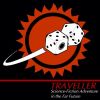Fringe Review: 1PG/Hero Force from ZDL's blog
But this one is different.
It then became something special. (Not perfect, mind. Special.)
Deep7, 1PG, and Heyoka: a legitimate phenomenon
In 2001 a little game was published by an outfit calling themselves Deep7. Entitled Shriek, it was a loving beer & pretzels game about cheesy teen slasher flicks. Todd Downing, the originator of the system, with development and revision done by both he and James Stubbs, is on the record as being somewhat surprised by the popularity of a game:
"I’ve got to be honest with you – I never expected the 1PG to be anything more than a few hours fun, or to go any farther than Shriek. Before I really understood what was happening, we had a sci-fi game, a western game, a pirate game, and we were selling the bloody things to an ever-growing online community of fans. … I had tried to fill a niche in the hobby and suddenly the little time-waster game system I’d written in four hours had to be all things to all people. Everyone was taking it for more than it was intended to be, good or bad." — Todd Downing in the 1PG Companion introduction
And an entire game line developed from a cheesy little throwaway game with evocative titles like Shriek, Bloode Island, Pax Gladius, Dime Heroes, Disaster!, and many others were published, and almost every one of them had extra adventure packs, campaign settings, and/or rules supplements provided. There was even a licensee publisher making products for this line (the aforementioned Heyoka)!
With 18 games and genres for this system, totalling up to about 70 different products, it's impossible for me to review it all. As a result I am going to focus on one game that is a) to my tastes, and b) in my opinion representative of the insane fun that is this line of games.
Hero Force: Super Adventure!
Hero Force: Super Adventure! (HFSA) is a game written by Mark Bruno, Todd Downing, and James Stubbs (three names you see again and again in the 1PG line). As the name would imply, it is in the superheroes genre. It has one rule book, one (licensed by Heyoka Studios) supplement called Giant Size Super Special (GSSS), and the general 1PG Companion (1PGC) applies to it as well. All three of these are the subject of this review.
The page count is amazingly tiny. HFSA itself is 13 pages long. The 1PGC is a further 24 pages. GSSS adds a further 29 pages. All three of them add to the overall experience, giving players the ability to scale to just how much they want from their beer & pretzels (as well as letting them choose the balance between libations and savoury snack, to hammer the metaphor into the ground with a spiked mallet).
Rules
In the main rules proper, a character is defined by four primary stats: Might, Looks, Guile, and Brains, each meaning pretty much what you'd guess. You roll 1d3 (yes, 1d3) for each. Each stat governs a set of skills: Looks, for example, governs Charisma, Fashion, and Seduction. You roll 1d3+3 for skill points to distribute over the skills (there are 17 skills in total). You may, at your choice, reduce skills (to a minimum stat+skill total of 1) to raise others.
Secondary stats also exist: Guts, Cool, Blood, and Fame/Infamy (the former for heroes, the latter for villains, but mechanically identical). Guts and Cool are 1d6 each. Guts and Cool work together to deal with character morale, in effect: you make a "Guts check" when something bad goes down, and if it fails, Cool drops a point. When Cool reaches 0, the character is twitchy, panicked, and now basically a liability to allies. Blood is 3d6+10 and is a hit point mechanism. When Blood drops to 0, the character dies. Fame/Infamy is a measure of how famous a character is and how likely it is that others (general public, enemies, law enforcement, etc.) know of it. Fame starts at 0, but a 1d6 roll equal to or under the four primary stats in sequence adds one to the fame giving starting characters anywhere from 0 to 4 Fame.
Unlike most modern superhero games, and nodding back to the good old days of Villains and Vigilantes, character origin and hero type are rolled on a table, not selected by the player. (More on this below.) In addition starting money of 2d6×$100 funds the character at the beginning of the game.
The game system is almost childishly simple (because beer & pretzels, dammit!). Any time an action is performed where the outcome is in doubt, take an applicable skill and the stat it falls under and add them together. This is a target number. Roll equal to it or below on 1d6. A 1 is always a success, no matter what, and a 6 is always a failure. The target number may be adjusted based on environment, etc. The difference between the target number and your die roll is a "margin of success" that the combat system uses.
Talking of which, in combat, both the attacker and the defender make their skill checks as appropriate at the same time. The larger margin of success wins: attacker rolls damage (removed from Blood) or defender evades the damage. Ties fall in favour of the defender. If both are attacking, ties resolve as a simultaneous success. Tests of wills can be 1d6 vs. Cool, augmented by fame/infamy. Whoever loses must make a Guts check or lose one point of Cool.
Every scenario's end, for surviving characters, 1d3+5 character points are awarded. They can be used to buy skills, Cool, Fame, Blood, or Guts.
As mentioned before the hero type and origin are both rolled. 1d6 on each table with types being Blaster, Mentalist, Elemental, Mystic, Vigilante, and Gadgeteer. Each has a bonus to a single stat (Mystics get +1 Cool, for example, while Blasters get +1 Guts), and a list of power types (categories) they can buy. Origins can be Alien, Construct, Divine/Immortal, Experiment, Mutant, or Training. Again each of these has bonuses, this time to stats or skills, depending on which.
Superpowers are selected according to the hero type, or from the "universal" list. The system is very open-ended and each category has some specialty rules for dealing with them. (Don't stress: it's all of one page!) For those who want more direction, there is a list of pre-made superpowers that can be just straight-up selected, or at the very least used as a model for other powers of the players' own design. (This is another single page.)
And that is the end of the actual rules. 7 pages total, including the cover and frontispiece, and the game rules are presented in their entirety. The rest of the rule book consists of five one-page (hence the 1PG name, I suspect) adventures (Better Dead Than Red!, Trouble Down Below, This Earth Consumed!, Shades of the Past, State of Emergency), and a final page that contains two character sheets.
It should be obvious by this point that this is not a serious game with long-term campaign potential. So obvious is this, in fact, that ... uh ... people demanded rules for that, to the consternation of the games' creators. This segues us nicely into...
Companions Don't Need Shuttles
The 1PGC is a 24-page book with a bunch of extra rules for beefing up the game from its hyper-simplistic roots. It begins with, of all things, the 1PG Tabletop System (1PGTS)—a miniatures system for combat!—with rules for vehicles (4 pages), mounted combat (1 page), brawling, movement, healing (not a feature of the original game!), and advanced firearms rules (1 page). Then there's 2.5 pages on how to run the game to suit other genre assumptions (mostly on the side of toughening up PCs), rules for character advancement, including the new concept of "stunts", rounding out the companion's rules in another final page.
After a page of design notes, some scenarios are bundled, for a variety of the games (very obviously a way to entice people into buying those as well, the efficacy of which I can shamefacedly confess to). Nine pages of these round out the booklet, each page having, as is usual for this line, one page to describe the scenario. As far as scenarios go they are good, solid 1PG entries, but the fact they're for a scattering of games reeks a bit of salesmanship.
As regards content, personally, although some of the rules in here are OK (healing, character advancement, adjustment of desired genre), I find most of the book pretty useless. The 1PGTS in particular is taking what is, to me, the entire appeal of 1PG games and throwing it into the scrap bin. It's no longer a quick pick-up game when you have to worry about how many 45-degree turns you can make in a single round according to character skill and vehicle speed. It's a pretty mixed bag as a supplement, and most of the time what you pull out is ... not really what you want soiling your hands.
I'm Super, Thanks for Asking!
The final part of the Hero Force portion of the 1PG line is the GSSS. This is, as mentioned before, a licensed product published by Heyoka Studios, an outfit which made several 1PG supplements. (This makes 1PG the only, to my knowledge, beer & pretzels game with licensed third-party product.)
As with the 1PGC, the GSSS is a small (29-page) supplement which expands on the game, in this case expanding specifically on HFSA. Written by Rob Garitta, it provides some enhancements to the game. The first of these is expanded rules for existing origins including the addition of a Sidekick origin. New character types are provided: the Combat Master, the Animalist, the Cyborg, the Brick, the Mastermind, and the Wielder, while also providing some guidelines in making new character types. New powers in the various categories are provided as well.
Actual game play rules are given as well: optional rules for less-lethal combat (especially brawling), and a new category of ability existing between skills and powers called "stunts". (Both of these seem to be modified versions of similar concepts from the 1PGC.)
This is the first 13 pages of the supplement. The remaining 16 are a setting, Victory City, and some adventures in said setting. This supplement is obviously made for people who want to use 1PG (and HFSA in particular) for longer-term games. It goes in-depth (for a beer & pretzels game!) into the setting's city, complete with its boroughs, key features in the boroughs, a round-up of the kinds of heroes found in said boroughs (including example heroes and villains, though these are made with the optional rules from the rules section, so it presupposes you'll be using them). The sections of the city are Beckton (wealthy, old-fashioned, high-powered heroes); The Core (a bizarre underground borough that serves as the core for government); North and South Argent (North is wealthy, South is poor, rivalry between the two extends to superheroes who are mutual rivals); Steeltown (industrial centre); and Black River (depressed, failed industrial zone dominated by a stand-offish large business).
This is the part of the book I enjoy the most. The rules are kind of "meh" for me. They're not bad. They're not good. They're just there. Did I use them? Yes. But that was largely because the sample characters used them and that segues into what I found so nice about GSSS.
The setting and its characters are utterly charming.
In eleven pages Garitta has managed to cram in enough detail to give the setting serious flavour. The boroughs come to life with spare use of wording, and a history of sorts is strongly implied at with passing mentions of things like the "Vampire Problem", the "Nanite Invasion", and things like that. None of this is detailed, but snippets are mentioned here and there as part of character or location backgrounds. This gives the feel of a living place while at the same time not constraining GMs and players in how and where to apply these.
A lot of this feel comes, too, from the characters presented as inhabiting the setting. Everything from nigh-cosmic level powers to barely-above-street-thug levels of power exist and are illustrated by several characters in each borough. Most of them are interesting and all of them contain little nuggets of RP hooks.
One criticism I'd muster of this, however, is that illustration in this section is not quite right. In many cases, for example, a character is described (Nike, for example) who is female, but the closest illustration is male. It turns out this is because that is part of (specifically the opponent in) an illustration for ANOTHER character, but it's a bit jarring visually. This isn't a huge deal, but it's a small blight on an otherwise charming production.
More seriously is a lack of any visual clue of how the city is laid out. I think a small overview map at least should have been provided, and maybe, too, one for each borough. It might add a page or three to the final product, but ... 32 pages is still a good, small book and that would give more room for GMs to picture the world.
The final five pages are, again, naturally, because that's how 1PG works, a set of single-page adventure seeds. They're good ones, but that's pretty much the norm for this game line. The game is there mostly to support the weird, wonderful, wacky game seeds.
Contemplation
1PG is not the first beer & pretzels game I've ever played. It's not even really the best designed, in terms of game mechanics. Yet over the years, this is the one I've kept. This is for several reasons.
First, despite its rather simplistic (and prone-to-killing-off-characters-like-flies) game system, it is a serviceable game that can be picked up by a newbie to role-playing entirely in under half an hour. (I've timed it.) Most other beer & pretzels games are aimed at existing gamers and play out as inside jokes that non-gamers won't get.
This leads to the next advantage: it's simple, fast, fun and designed for pick-up play, but it is not a joke game. It is a real, serious, RPG for the kinds of genres that are common in RPG lines. Because of this it's actually a pretty good gateway game for non-gamers to be introduced to the notion of RPGs.
Adding to this is that there is an awful lot of creativity stuffed into this line. 18 genres are covered (to varying degrees of success, mostly pretty good) and there are literally hundreds of adventure ideas to be fleshed out into fun games. The GM will need to do a modicum of preparation for each (like sketching out a quick map, say, or fleshing out an NPC), but given the simplicity of the game system this is not a lot of work.
There are some down sides, however, depending on where you approach the game from. From reading the 1PGC introduction it seems a lot of people missed the part where the game is intended as pure, pick-up, disposable fun and not serious, long-term gaming. If you come at the game from that angle, you will probably not like this game. This isn't to say the game is bad or that you are wrong. It's to say that the game and you are a poor fit.
If, on the other hand, you walk into the game—whichever one of the line—knowing in advance what you're getting into (pure, quick pick-up fun with no intent for anything beyond that) the game works well.
















The Wall